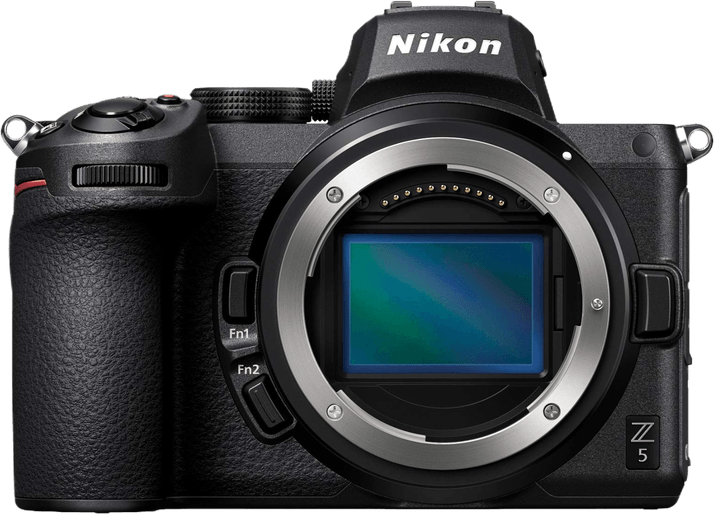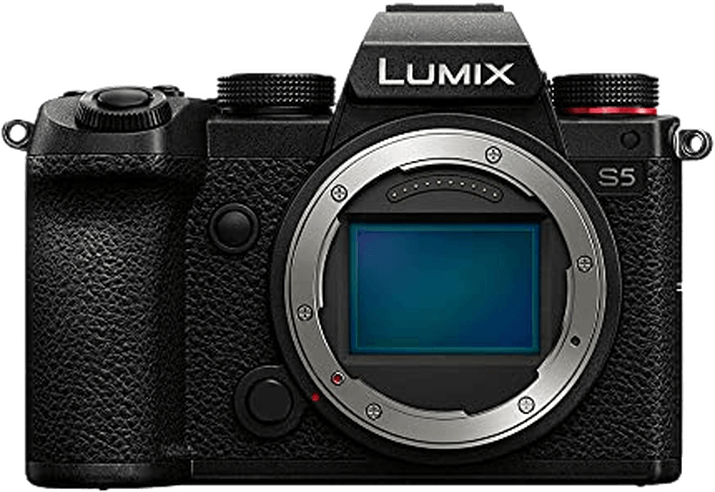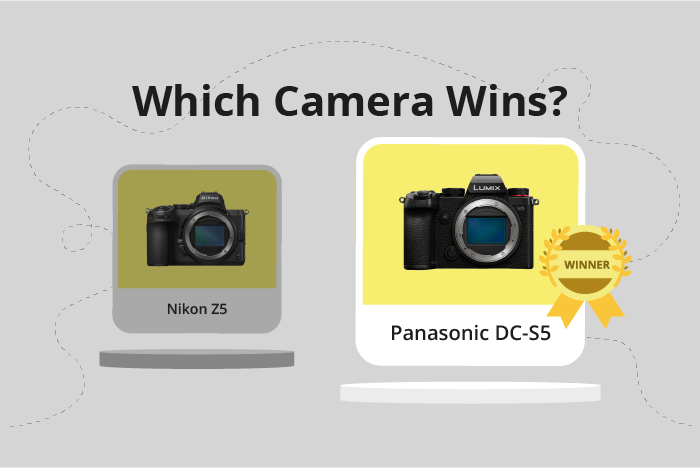Nikon Z5 vs Panasonic Lumix DC-S5 Comparison
Nikon Z5

Panasonic Lumix DC-S5

The Panasonic Lumix DC-S5 edges out the Nikon Z5 with a score of 79/100 compared to 78/100. Both cameras are mirrorless and were released in 2020 and 2021, respectively. They have similar sizes, with the Lumix DC-S5 measuring 133 x 97 x 82mm and the Z5 at 134 x 100.5 x 69.5mm. The Lumix DC-S5 weighs slightly more at 714g, while the Z5 weighs 675g.
The Lumix DC-S5 is better due to its higher score, but it also comes with a higher launch price of $1999 compared to the Z5’s $1400. This difference in price may be a factor for some buyers. The Nikon Z5, although scoring slightly lower, offers a more affordable option without sacrificing too much in terms of performance and features.
Considering the one-point difference in scores, both cameras have their merits. The Panasonic Lumix DC-S5 has a slight advantage in terms of performance, while the Nikon Z5 is a more budget-friendly option. Ultimately, the choice between these two cameras will depend on the individual’s preferences and budget.
Nikon Z5 vs Panasonic Lumix DC-S5 Overview and Optics
The Nikon Z5 outperforms the Panasonic Lumix DC-S5 in optics with a score of 81/100 compared to the Lumix DC-S5’s 78/100. Both cameras share several specifications, including 24-megapixel CMOS sensors, full-frame sensor size, and image stabilization. Despite these similarities, the Nikon Z5 proves to be superior in certain aspects.
The Nikon Z5’s Expeed 6 processor and DXOMARK sensor score of 97 contribute to its edge over the Panasonic Lumix DC-S5, which has a Venus Engine processor and a DXOMARK sensor score of 94. The higher DXOMARK sensor score means the Z5 has better overall image quality. Additionally, the Nikon Z5 uses the Nikon Z lens mount, providing access to a wide range of high-quality lenses.
On the other hand, the Panasonic Lumix DC-S5 has a faster shooting speed of 7 frames per second compared to the Nikon Z5’s 4.5 frames per second. This can be advantageous for capturing fast-moving subjects and action photography. The Lumix DC-S5 also uses the Leica L lens mount, allowing for compatibility with premium Leica lenses.
Taking these factors into account, the Nikon Z5 offers superior image quality and a broader selection of lenses, making it the better choice for those prioritizing optics. However, the Panasonic Lumix DC-S5’s faster shooting speed may appeal to action photographers or those who require quick capture capabilities. Ultimately, the choice between these two cameras depends on the user’s specific needs and priorities in terms of optics and performance.
Nikon Z5 vs Panasonic Lumix DC-S5 Video Performance
The Nikon Z5 and the Panasonic Lumix DC-S5 both have a video score of 83/100, showing that they are competitive in terms of video capabilities. Each camera shares common specifications, such as a maximum video resolution of 4K, video dimensions of 3840 x 2160, a maximum video frame rate of 60fps, and built-in time-lapse functionality.
However, there are aspects where one camera may outperform the other. For instance, the Nikon Z5 may have a better autofocus system, resulting in smoother and more accurate focus transitions during video recording. Additionally, the Nikon Z5 might provide superior color reproduction and dynamic range, which would lead to more visually appealing videos.
On the other hand, the Panasonic Lumix DC-S5 could potentially offer better low-light performance, allowing for cleaner video recordings in dimly lit environments. The DC-S5 may also have a more advanced image stabilization system, reducing camera shake and providing smoother footage during handheld recording.
Ultimately, both cameras are strong contenders in terms of video capabilities, with the Nikon Z5 excelling in autofocus performance, color reproduction, and dynamic range. Meanwhile, the Panasonic Lumix DC-S5 stands out for its low-light performance and image stabilization. Users should consider these factors when choosing between the two cameras for their specific video needs.
Nikon Z5 vs Panasonic Lumix DC-S5 Features and Benefits
The Panasonic Lumix DC-S5 outperforms the Nikon Z5 with a feature score of 85/100, compared to the Nikon Z5’s 72/100. Both cameras share several specifications, including a touchscreen, flip screen, WIFI, and Bluetooth connectivity. However, neither camera offers GPS functionality.
The Lumix DC-S5 excels in screen resolution, providing 1,840,000 dots, whereas the Nikon Z5 offers 1,040,000 dots. This higher resolution results in a sharper and clearer image display, making it easier for photographers to review their shots and adjust settings. The Lumix DC-S5’s superior feature score reflects these advantages.
On the other hand, the Nikon Z5 has a slightly larger screen size at 3.2 inches compared to the Lumix DC-S5’s 3 inches. This larger screen may provide a more comfortable viewing experience for some users, despite its lower resolution.
Considering the feature scores and specifications, the Panasonic Lumix DC-S5 emerges as the better camera due to its higher screen resolution, which contributes to a more enjoyable user experience. The Nikon Z5’s larger screen size does not compensate for its lower resolution, as the difference in size is minimal. Therefore, the Panasonic Lumix DC-S5 is the recommended choice for those seeking a camera with superior features and performance.
Nikon Z5 vs Panasonic Lumix DC-S5 Storage and Battery
The Nikon Z5 takes the lead in storage and battery with a score of 73/100, while the Panasonic Lumix DC-S5 trails closely behind at 71/100. Both cameras share common specifications such as having two memory card slots and accepting SD/SDHC/SDXC (UHS-II compatible) memory cards. They also both offer USB charging capabilities.
The Nikon Z5 stands out with its slightly longer battery life of 470 shots, as opposed to the Lumix DC-S5’s 440 shots. This advantage allows users to take more photos before needing to recharge or replace the battery. The Z5 uses an EN-EL15c battery type, contributing to its superior performance in this aspect.
On the other hand, the Lumix DC-S5 does not offer any significant advantages in storage and battery compared to the Nikon Z5. It uses a DMW-BLK22 battery type and has a marginally shorter battery life.
Taking these factors into account, the Nikon Z5 proves to be the better choice for storage and battery performance. However, the difference in scores is marginal, and both cameras provide satisfactory storage options and battery life for most users.
Alternatives to the Nikon Z5 and Panasonic Lumix DC-S5
Are you still undecided about which camera is right for you? Have a look at these popular comparisons that feature the Nikon Z5 or the Panasonic Lumix DC-S5:

